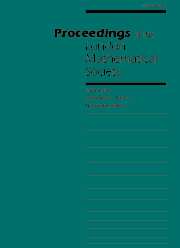Article contents
SUR L’ÉQUATION DIOPHANTIENNE (xn − 1)/(x − 1) = yq, III
Published online by Cambridge University Press: 13 February 2002
Abstract
In this paper we study the diophantine equation of the title, which was first introduced by Nagell and Ljunggren during the first half of the twentieth century. We describe a method which allows us, on the one hand when n is fixed, to obtain an upper bound for q, and on the other hand when n and q are fixed, to obtain upper bounds for x and y which are far sharper than those derived from the theory of linear forms in logarithms. We also show how these bounds can be used even when they seem too large for a straightforward enumeration of the remaining possible values of x. By combining all these techniques, we are able to solve the equation in many cases, including the case when n has a prime divisor less than 13, or the case when n has a prime divisor which is less than or equal to 23 and distinct from q.
2000 Mathematical Subject Classification: primary 11D41; secondary 11J86, 11Y50.
Information
- Type
- Research Article
- Information
- Copyright
- 2002 London Mathematical Society
- 11
- Cited by

